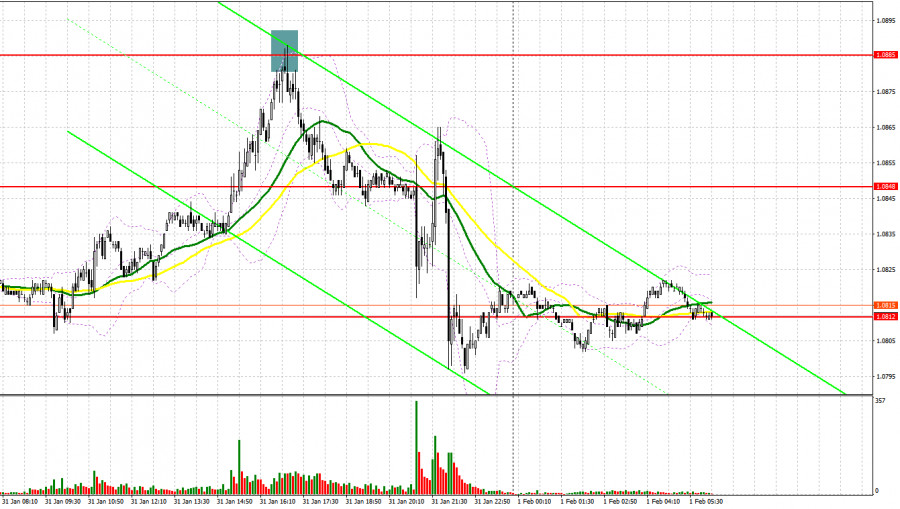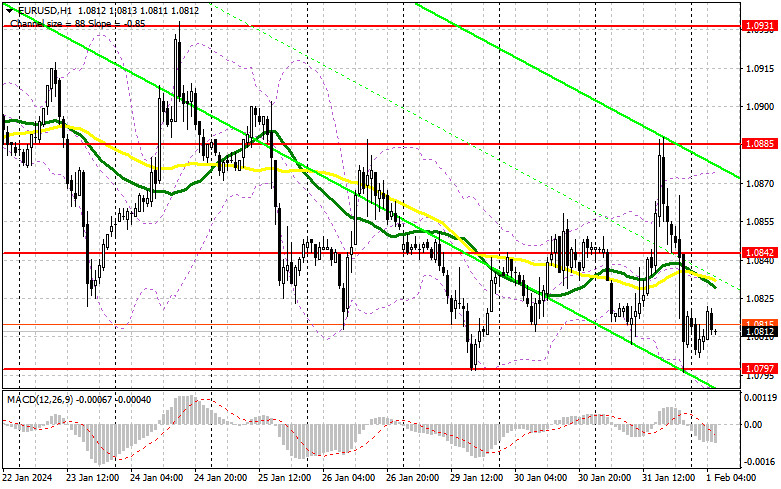
Yesterday, the pair formed several entry signals. Let's take a look at the 5-minute chart and discuss what happened. In my previous forecast, I focused on the level of 1.0812 and recommended making market entry decisions based on it. A decline and false breakout near 1.0812 generated a buy signal. As a result, the pair rose by 30 pips. In the afternoon, a false breakout at 1.0885 produced a sell signal, which sent the pair down by more than 40 pips.

For long positions on EUR/USD
The euro rose after the ADP jobs report showed slowing US employment; however, the Federal Reserve's decision to leave rates unchanged, and only dropping the disposition that rates could be raised if necessary, had led to the pair's sharp decline and the US dollar strengthened at the end of the day. Today, we have quite a bit of data for the eurozone, starting with business activity indices in the manufacturing sectors of Germany, France, and Italy, as well as overall data for the eurozone. An upward revision may support the single currency. The eurozone Consumer Price Index will be in focus, particularly core prices; a decline in values will weaken the euro and lead to a new sell-off, which will extend yesterday's trend.
In this case, I will act only after a false breakout forms near the nearest support at 1.0812, established yesterday. This would be a suitable option for me to enter the market, in anticipation of a minor bullish correction to the area of 1.0842. Just below this level, we have the moving averages that favor the bears. A breakout and a downward test of this range will create an entry point for long positions, providing an opportunity for a correction and the prospect of testing 1.0885. The ultimate target is found at the 1.0931 high, where I plan to take profits. Should EUR/USD decline and show no activity at 1.0797 in the first half of the day, the pressure on the pair will return. In this case, I will try to enter the market after a false breakout forms near 1.0762. I would consider opening long positions on a rebound from 1.0727, aiming for an upward correction of 30-35 pips within the day.
For short positions on EUR/USD:
The bears still have the chance to build a new trend - especially after yesterday's US central bank meeting, where Fed Chairman Jerome Powell made it clear that there will be no rate cut in March. Safeguarding 1.0842 and forming a false breakout there after the release of various reports on the eurozone countries will indicate the presence of big players in the market, which could send the pair down to 1.0797. Only after a breakout and consolidation below this range, as well as an upward retest, do I expect another sell signal, and the pair could fall to 1.0762. The ultimate target here is 1.0727, where I plan to take profits. In case EUR/USD moves upwards during the European session without bearish activity at 1.0842, the demand for EUR/USD will return, so the euro may recover, and the pair will continue to trade within the sideways channel. In such a case, it will be possible to enter the market after a test of the next resistance at 1.0885. It is also possible to sell there but only after a false breakout. I plan to initiate short positions on a rebound from 1.0931, aiming for a downward correction of 30-35 pips.

COT report:
In the COT report (Commitment of Traders) for January 23, there was a decrease in long positions and an increase in short positions, indicating a shift in favor of the US dollar. After the European Central Bank meeting, where the central bank made it clear that they plan to lower interest rates as early as this summer, the euro came under pressure again. Buyers have nothing to worry about, as the strong US economy allows the Federal Reserve to stick to its tough policy without fearing a recession, unlike the eurozone economy. The Federal Open Market Committee will be held this week, afterwards it will be clear what the central bank plans to do with its policy. The COT report indicated that long non-commercial positions fell by 9,104 to 195,190, while short non-commercial positions increased by 6,664 to 106,866. As a result, the spread between long and short positions increased by 1,179.
Indicator signals:
Moving averages:
Trading below the 30- and 50-day moving averages indicates a possible decline in the pair.
Please note that the time period and levels of the moving averages are analyzed only for the 1H chart, which differs from the general definition of the classic daily moving averages on the 1D chart.
Bollinger Bands
If EUR/USD declines, the indicator's lower border near 1.0790 will serve as support.
Description of indicators:
• A moving average of a 50-day period determines the current trend by smoothing volatility and noise; marked in yellow on the chart;
• A moving average of a 30-day period determines the current trend by smoothing volatility and noise; marked in green on the chart;
• MACD Indicator (Moving Average Convergence/Divergence) Fast EMA with a 12-day period; Slow EMA with a 26-day period. SMA with a 9-day period;
• Bollinger Bands: 20-day period;
• Non-commercial traders are speculators such as individual traders, hedge funds, and large institutions who use the futures market for speculative purposes and meet certain requirements;
• Long non-commercial positions represent the total number of long positions opened by non-commercial traders;
• Short non-commercial positions represent the total number of short positions opened by non-commercial traders;
• The non-commercial net position is the difference between short and long positions of non-commercial traders.